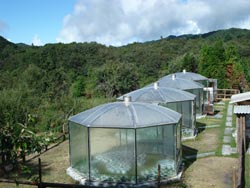
Understanding the interactions between ecological systems with the environment is a research priority in areas such as global change, evolutionary biology, and functional genomics. Controlled environment facilities, like a CO2 phytotron, which is mad up of completely closed greenhouses for the study of environmental conditions on plant growth, are necessary for studying these interactions.
Recently, a CO2 phytotron was set up in Ailaoshan Mountains by researchers with Ailaoshan Station for Subtropical Forest Ecosystem Studies under the CAS Xishuangbanna Tropical Botanical Garden (XTBG) in southwest China's Yunnan Province.
Experts say that the controlled environmental facility will enable researchers to carry out studies on interrelationships between biological invasion and global change, and the evolution of exotic plants under environmental changes (such as the increased CO2 density, temperature, and nitrogen deposition).
Due to its high elevation and latitude of the Ailaoshan Mountains, the local ecological system is more sensitive to the climatic change, and its response to the global change could be used as indicators for studies in the field. Lying at the southeast tip of the Qinghai-Tibet Plateau, the Ailaoshan Mountains sprawl in the transitional zone ranging from the inner core of the Yunnan Province's sub-tropical belt to its northern fringe, where tropical, sub-tropical and temperate floras are converged and crisscrossed.
Against such a background, the native biodiversity and floral phylogeny present an extremely complicated and diversied distribution layout. As the progressive course of global climate change speeds up, the local ecosystem is more capable of dramatically reflecting the impacts imposed by the global environmental changes in Ailaoshan Mountains. It is very likely to serve as a natural laboratory versed in exploring the mutual coupling and interaction between processes within an ecosystem and the current climate change.
The phytotron, which houses four plant growth greenhouse chambers and a laboratory, is aimed at carrying out a new control-and-test approach by integrating bio-invasion ecology with the on-going global warming, exploring the evolution of the aggressiveness developed in the intruding floral species against a complete set of changed ecological conditions as result of the global warming (such as the increased content of CO2 in the air, the current temperature hike, subsidence of nitrogen and its compounds, etc.) in addition to the prediction of the possible distributive layout of the alien species, the early warning of the changes, identification of the weak links and restrictive factors in the dissipative process of the intruding species. Based on these, related countermeasures are to be formulated in a bid to stop their propagation and develop new methods of scientific management for their control and prevention. In order to rehabilitate the depleted ecosystems, scientific guidance might be provided for the control and experimentation of the bio-invasion in the Mountains. By using the phytotron, scientists can predict the possible distribution of invaded plant species, discover the vulnerable spots and limiting factors, and make an early warning,
Established in 1981, the Ailaoshan Station focuses its studies on sub-tropical forest ecosystems. Its main task is to carry out research in the fields of forest ecology and conservation biology of sub-tropical forests, especially the pattern of species diversity and its maintenance, dynamic process of ecosystem, the driving forces of an ecosystem degradation and the associated restoration and the biological base for some important ecological phenomena. At the same time, the station conducts research into landscape scale acting an important role in monitoring and recovering the sub-tropical mountainous environment of southwestern China.







